A Physical and Spectroscopic Survey of the Lunar South Pole with the Galileo Telescope of the Asiago Astrophysical Observatory
Abstract
:1. Introduction
2. The Lunar South Pole
2.1. Physical Analysis
- Water ice in polar areas;
- Non-polar hydrogen and oxygen implanted in the lunar regolith from the solar wind;
- Regolith-implanted helium-3 from the solar wind. Helium-3 could provide nuclear energy in a fusion reactor with the advantages that it is not radioactive and it would not produce dangerous waste products; all these hypotheses are under investigation;
- Uranium and thorium in silica-rich domes and KREEP basalts on the lunar nearside, other important elements for the developments of space-based nuclear power and nuclear propulsion concepts;
- Basalt-hosted metals such as titanium, iron and aluminum (Papike et al. For example, the main Ti-bearing phase in lunar rocks is the mineral ilmenite particularly accredited for the retention of some solar wind-implanted volatiles and for ISRU oxygen extraction;
- Volatiles and elements of pyroclastic origin that include iron, zinc, cadmium, mercury, lead, copper and fluorine;
- Rare metals and platinum-group elements such as nickel, platinum, palladium, iridium and gold that may occur within segregated impact melt sheets and layered mafic extrusives;
- Other volatiles such as nitrogen, carbon and lithium in breccia or exhalative deposits.
2.2. Lunar Volatiles
2.3. Candidate Locations for Future Lunar Settlements
- The availability of water. In particular, a Diviner average temperature lower than 110 K. In this way, water ice is supposed to be stable at the surface and enhanced H signatures > 100 ppm by weight so ice should be present close to the surface; this last value derives from the LPNS, where a lower value means that the presence of water ice might be located deeper and so be harder to reach.
- The slopes of the terrain should be less than 20°. Based on the state of the art, lunar mission slopes greater than 15° can lead to the overturn of a lander while slopes up to 20° could guarantee safer extra vehicular activities.
- Usable energy source. Regions with a relatively higher average solar illumination (>50% of the lunar day) for power generation by solar panels.
- Communication link. Semi-continuous visibility of Earth is essential for the remote control of robotic operations and crew safety during the initial phase of lunar exploration programs when relay communication infrastructures will not yet be implemented.
- The base site should have enough areas for regular support ground operations and expansion (e.g., extra vehicular activities, EVAs)
- Abundance of mineral resources.
- Scientific interest to deepen the origin of our natural satellite.
3. Spectroscopic Survey
3.1. The Galileo Telescope and Its Instrumentation
3.2. Reduction of the Data Obtained with the Galileo Telescope
- The BIAS(x,y) is obtained with the shutter closed and an exposure time of 0 s, i.e., 0 photoelectrons collected; in this way, subtracting photo-electrons from the scientific image countings due to instrumental effects are eliminated.
- The flat-field FF(x,y) is obtained by pointing the telescope towards the closed dome illuminated by the uniform light from a lamp (this method is also known as dome flat). Thus, the obtained spectrum is composed of the continuum spectrum from the lamp, the response curve of the CCD and the non-uniform pixel response.
- The DARK(x,y) is due to the eddy currents that are generated in the CCD caused by thermal agitation. This contribution can be neglected because modern CCDs are kept at very low temperatures (−80/90 °C).
- Other images used are those of the He-Fe-Ar lamp and the standard star, respectively, for the wavelength calibration and the flux calibration.
Solar Analogs
3.3. Observing Campaign
- The Moon’s brightness is the first relevant driver. To avoid saturation of the image, the exposure time needs to be properly reduced. The saturation occurs when the countings exceed this value 2nbit, i.e., 65,536 counts; however, the sensor loses linearity beyond 40,000 counts while under 30,000 counts, the signal to noise ratio (SNR) increases.
- Exposure time below the second might give rise to some errors due to the calibration of the mechanical shutter being set on poses of several minutes. During a full Moon, it is necessary to act on the diaphragm aperture, which has to be rightly closed to minimize faults that affect the flux results and to extend the exposure time; because of this, a good spatial resolution for the guide camera could be lost.
- The Moon’s proximity to the Earth causes a rapid variation in the Moon’s coordinates, and robotically or differential tracking are not possible; for example, the Schimdt (the robotic telescope of the INAF Astronomic Observatory of Padua), in addition to not pointing at the Moon, cannot even approach it. Nonetheless, the Galileo Telescope has the ability to perform manual tracking at three different speeds; in this way, we can follow the Moon’s motion seamlessly and we have freedom of choice in the observable areas. This is not a common feature but thanks to that, the tracking of the selected bright zone has been performed in a meticulous way.
- The guide camera does not have a high resolution due to air turbulence and it works poorly in a high illumination condition; so, positioning the slit on the right zone and navigating on the lunar surface is not always an easy issue. This phenomenon of image distortion is augmented when approaching polar latitudes due to the Moon’s sphericity.
- Another important aspect is bound up with the subtraction of the sky’s emission. This operation can be performed in different positions depending on the objective of the observations; in most instances, a compromise is necessary. For example, the Moon has an exosphere up to 500 km thick, which does not need to be considered for a lunar surface spectroscopy analysis. This is ensured by the length of the slit (8.5 arcminutes on the celestial plane, about 950 km of field of view in width) that allows extracting the lines of the sky without “contaminating” the final spectrum.
- The back-illuminated ANDOR sensor provides an excellent performance in ultraviolet, while suffering from fringing (photons interference) in the near-infrared due to sensor thinning. All the spectra presented hereafter are aptly cut in the way of not displaying the wavelength where this phenomenon occurs.
- Unfortunately, it is not possible to make many observations; only two or three nights per month with a favorable libration are exploitable. Our principal constraint is the libration in latitude, which results in a modest inclination (an average of 6.7° in modulus) between the Moon’s axis of rotation and the normal to the plane of its orbit around Earth; Galileo Galilei was sometimes credited with the discovery of this specific lunar motion. The slightest value of libration makes the lunar south pole visible for an observer on Earth. This kind of lunar motion is simplified in Figure 7 to make understanding more intuitive. The lunar ephemeris has been obtained from [25].
- Lastly, such a detailed spectroscopy survey of the Moon has never been made with the Galileo Telescope and so several attempts were required.
3.4. Results
3.4.1. Grating: 300
3.4.2. Grating: 1200 R
3.4.3. Grating: 1200 B
3.4.4. Grating: 600 V
4. Discussion
- Flexibility in the set up and observational procedure;
- Quick access to the astronomic observatory structures;
- Rapid intervention. In the case of out-of-the-ordinary phenomena, it is possible to observe almost in real time. An example could be the dust plume that arose from the crash of a spacecraft on the lunar surface as happened with the private Japanese Hakuto-R Mission 1 in April 2023, the Roscosmos mission Luna 25 in August 2023 or how it could have happened with the Peregrine lander in January 2024. Events of this nature can offer great opportunities to study the lunar surface in an unusual way.
- The possibility of following from beginning to end the observational procedure and obtaining “own measurements”. This is one of the most important points because the observer knows how he obtained those results and, in case of need, he can improve or modify them.
5. Conclusions
Author Contributions
Funding
Data Availability Statement
Conflicts of Interest
Appendix A
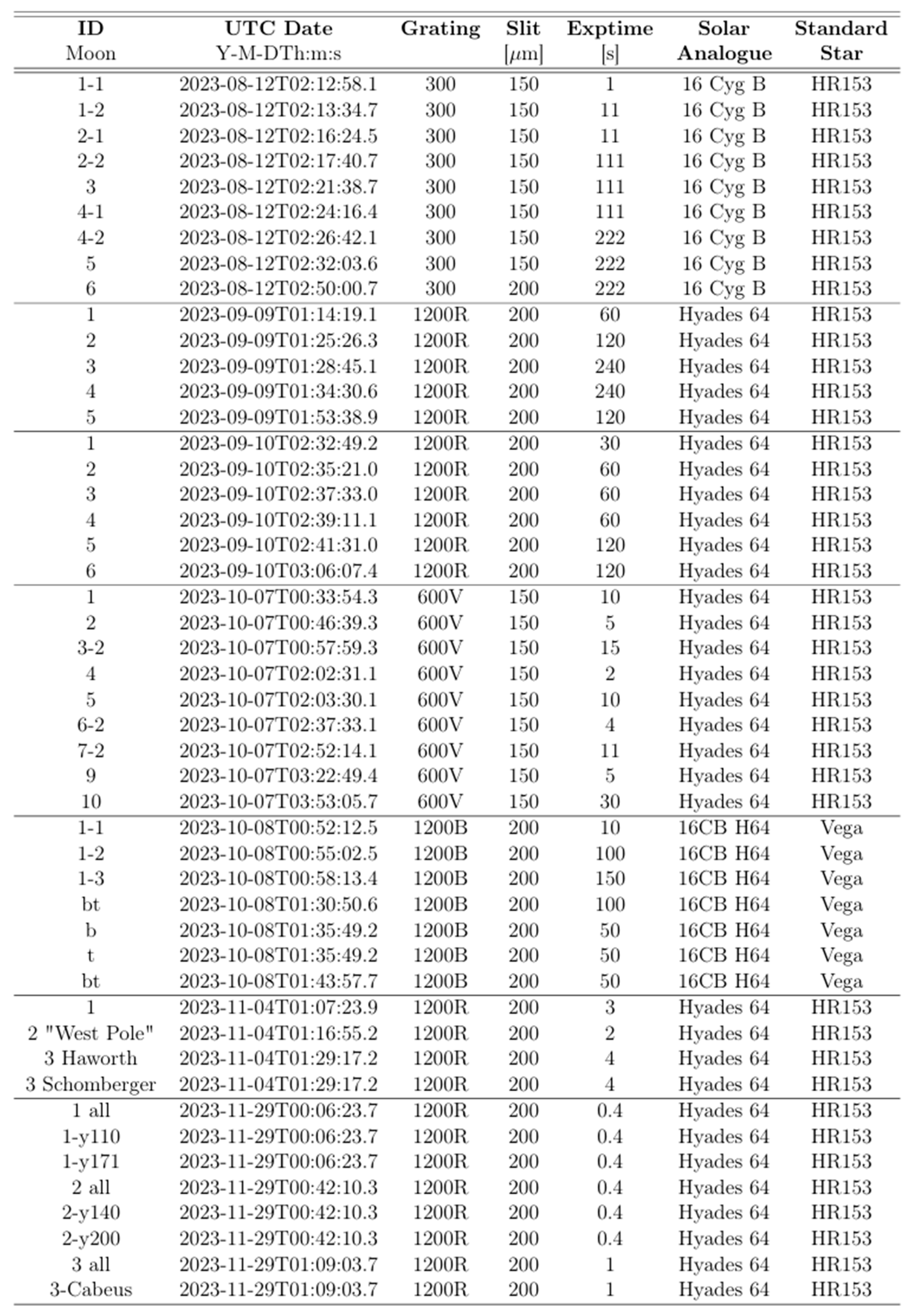
References
- Bhamidipati, S.; Mina, T.; Sanchez, A.; Gao, G. Satellite Constellation De sign for a Lunar Navigation and Communication System. NAVIGATION J. Inst. Navig. 2023, 70, navi.613. [Google Scholar]
- The International Space Exploration Coordination Group. Available online: https://www.globalspaceexploration.org (accessed on 12 July 2024).
- Ouyang, Z.Y. Cosmochemistry; Beijing Science Press: Beijing, China, 1989; Volume 93. [Google Scholar]
- Zou, Y.L.; Liu, J.Z.; Liu, J.J.; Xu, T. Reflectance spectral characteristics of Lunar surface materials. Chin. J. Astron. Astrophys. 2004, 4, 97. [Google Scholar] [CrossRef]
- Crawford, I.A. Lunar resources: A review. Prog. Phys. Geogr. 2015, 39, 137–167. [Google Scholar] [CrossRef]
- Ambrose, W.A.; Cutright, B.L. Water Ice Resources on the Moon; Gulf Coast Association of Geological Societies Transactions: Nacogdoches, TX, USA, 2023; Volume 72, pp. 231–241. [Google Scholar]
- Spudis, P.D.; Gillis, J.J.; Reisse, R.A. Ancient multiring basins on the Moon revealed by Clementine laser altimetry. Science 1994, 266, 1848–1851. [Google Scholar] [CrossRef] [PubMed]
- Unified Geologic Map of the Moon. Available online: https://astrogeology.usgs.gov/search/map/Moon/Geology/Unified_Geologic_Map_of_the_Moon_GIS_v2 (accessed on 12 July 2024).
- Mazarico, E.; Neumann, G.A.; Smith, D.E.; Zuber, M.T.; Torrence, M.H. Illumination conditions of the lunar polar regions using LOLA topography. Icarus 2011, 211, 1066–1081. [Google Scholar] [CrossRef]
- Lunar South Pole Atlas. Available online: https://www.lpi.usra.edu/lunar/lunar-south-pole-atlas/ (accessed on 12 July 2024).
- O’Brien, P.; Byrne, S. Mapping Lunar Double Shadows with Digital Terrain Models. LPI Contrib. 2022, 2703, 5012. [Google Scholar]
- Mahanti, P.; Robinson, M.S.; Wagner, R.; Estes, N.; Humm, D.C. First Look, First Results-Comparing Secondary Illumination at Lunar Permanently Shadowed Regions from the First Shadowcam Image and Topography Based Simulation. In Proceedings of the IGARSS 2023-2023 IEEE International Geoscience and Remote Sensing Symposium, Pasadena, CA, USA, 16–21 July 2023; IEEE: Piscataway, NJ, USA, 2023; pp. 4162–4165. [Google Scholar]
- Moriarty, D.P.; Watkins, R.N.; Petro, N.E. Mineralogical diversity of the lunar south pole: Critical context for artemis sample return goals and interpretation. In Proceedings of the Lunar Surface Science Workshop, Virtual, 28–29 May 2020; Volume 2241, p. 5152. [Google Scholar]
- Wu, Y.; Hapke, B. Spectroscopic observations of the Moon at the lunar surface. Earth Planet. Sci. Lett. 2018, 484, 145–153. [Google Scholar] [CrossRef]
- Li, S.; Lucey, P.G.; Milliken, R.E.; Hayne, P.O.; Fisher, E.; Williams, J.P.; Hurley, D.M.; Elphic, R.C. Direct evidence of surface exposed water ice in the lunar polar regions. Proc. Natl. Acad. Sci. USA 2018, 115, 8907–8912. [Google Scholar] [CrossRef]
- Hurley, D.; Colaprete, A.; Elphic, R.; Farrell, W.; Hayne, P.; Heldmann, J.; Hibbitts, C.A.; Hurley, D.M.; Livengood, T.A.; Sherwood, B.; et al. Lunar Polar Volatiles: Assessment of Existing Observations for Exploration; NASA Goddard Space Flight Center: Greenbelt, MD, USA, 2016.
- Flahaut, J.; Carpenter, J.; Williams, J.P.; Anand, M.; Crawford, I.A.; van Westrenen, W.; Füri, E.; Xiao, L.; Zhao, S. Regions of interest (ROI) for future exploration missions to the lunar South Pole. Planet. Space Sci. 2020, 180, 104750. [Google Scholar] [CrossRef]
- Livengood, T.A.; Chin, G.; Boynton, W.; McClanahan, T.P.; Su, J.J. Latitude Dependence of the Hydrogen/Water Concentration in the Lunar Surface Measured by LRO/LEND. In AAS/Division for Planetary Sciences Meeting Abstracts; American Astronomical Society: Washington, DC, USA, 2022; Volume 54, p. 316.04. [Google Scholar]
- Killen, R.M.; Potter, A.E.; Hurley, D.M.; Plymate, C.; Naidu, S. Observations of the lunar impact plume from the LCROSS event. Geophys. Res. Lett. 2010, 37. [Google Scholar] [CrossRef]
- Heldmann, J.L.; Lamb, J.; Asturias, D.; Colaprete, A.; Goldstein, D.B.; Trafton, L.M.; Varghese, P.L. Evolution of the dust and water ice plume components as observed by the LCROSS visible camera and UV–visible spectrometer. Icarus 2015, 254, 262–275. [Google Scholar] [CrossRef]
- de Castro, N.W.; Li, S. Characterizing Spectral Features of Water-ice, Lunar Regolith Simulants, and their Mixtures at the VIS-NIR Region. LPI Contrib. 2022, 2703, 5035. [Google Scholar]
- Sanin, A.B.; Mitrofanov, I.G.; Litvak, M.L.; Bakhtin, B.N.; Bodnarik, J.G.; Boynton, W.V.; Vostrukhin, A.A. Hydrogen distribution in the lunar polar regions. Icarus 2017, 283, 20–30. [Google Scholar] [CrossRef]
- Leone, G.; Ahrens, C.; Korteniemi, J.; Gasparri, D.; Kereszturi, A.; Martynov, A.; Schmidt, G.W.; Calabrese, G.; Joutsenvaara, J. Sverdrup-Henson crater: A candidate location for the first lunar South Pole settlement. Iscience 2023, 26, 107853. [Google Scholar] [CrossRef] [PubMed]
- Moon Trek. Available online: https://trek.nasa.gov/moon/index.html#v=0.1&x=0&y=0&z=1&p=urn%3Aogc%3Adef%3Acrs%3AEPSG%3A%3A104903&d=&locale=&b=moon&e=-300.05858815283705%2C-157.85155955550536%2C300.05858815283705%2C157.85155955550536&sfz=&w= (accessed on 12 July 2024).
- Geocentric Ephemeris for the Moon. Available online: https://astropixel.com/ephemeris/moon.html (accessed on 12 July 2024).
- Lemelin, M.; Camon, A.; Li, S.; Diotte, F.; Lucey, P.G. Water Ice Detections in the Polar Regions using the Kaguya Spectral Profiler. LPI Contrib. 2022, 2703, 5039. [Google Scholar]
- Lauretta, D.S.; Connolly, H.C., Jr.; Aebersold, J.E.; Alexander, C.M.O.D.; Ballouz, R.L.; Barnes, J.J.; Bates, H.C.; Bennett, C.A.; Blanche, L.; OSIRIS-REx Sample Analysis Team; et al. Asteroid (101955) Bennu in the laboratory: Properties of the sample collected by OSIRIS-REx. Meteorit. Planet. Sci. 2024. [Google Scholar] [CrossRef]

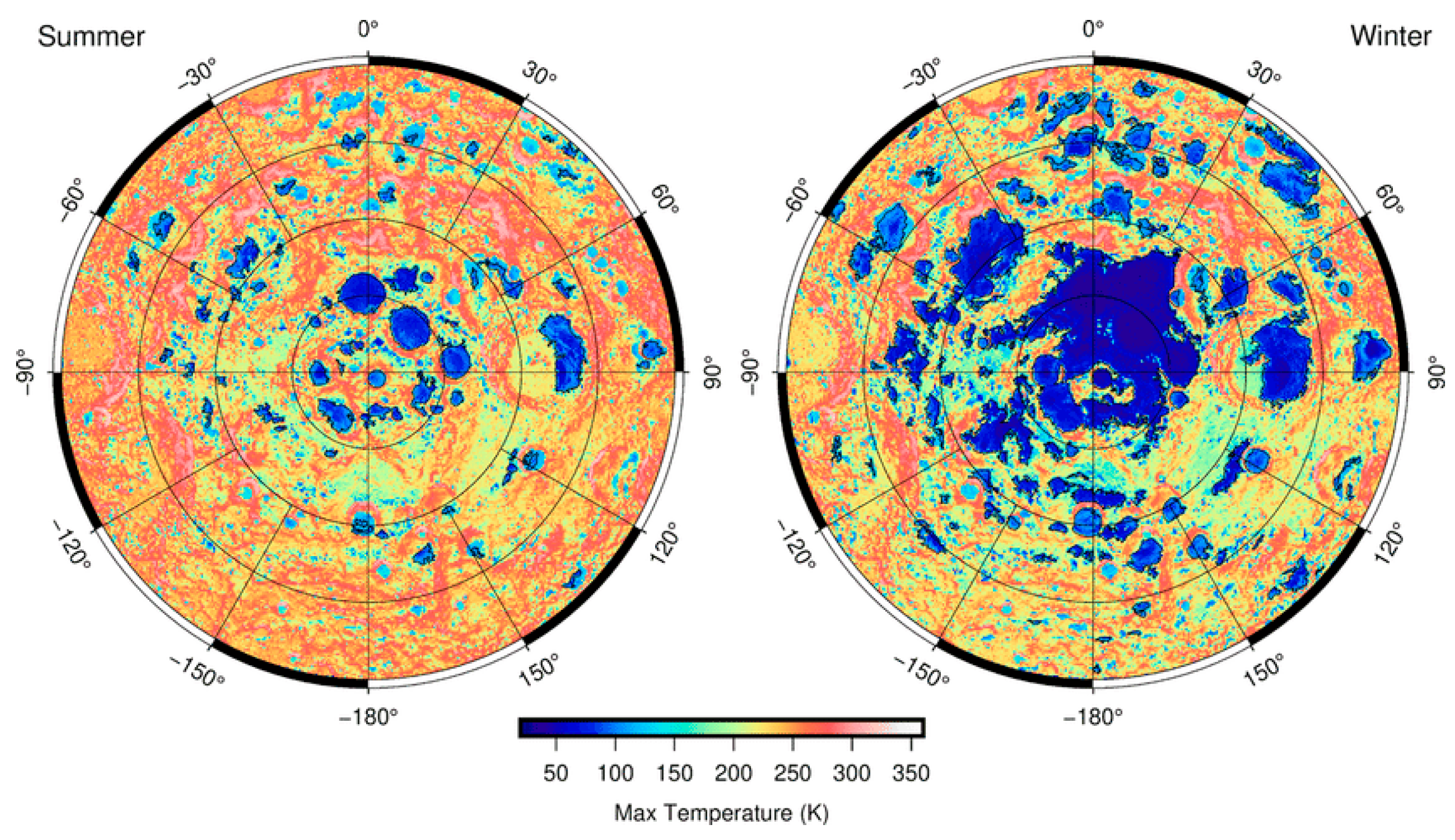
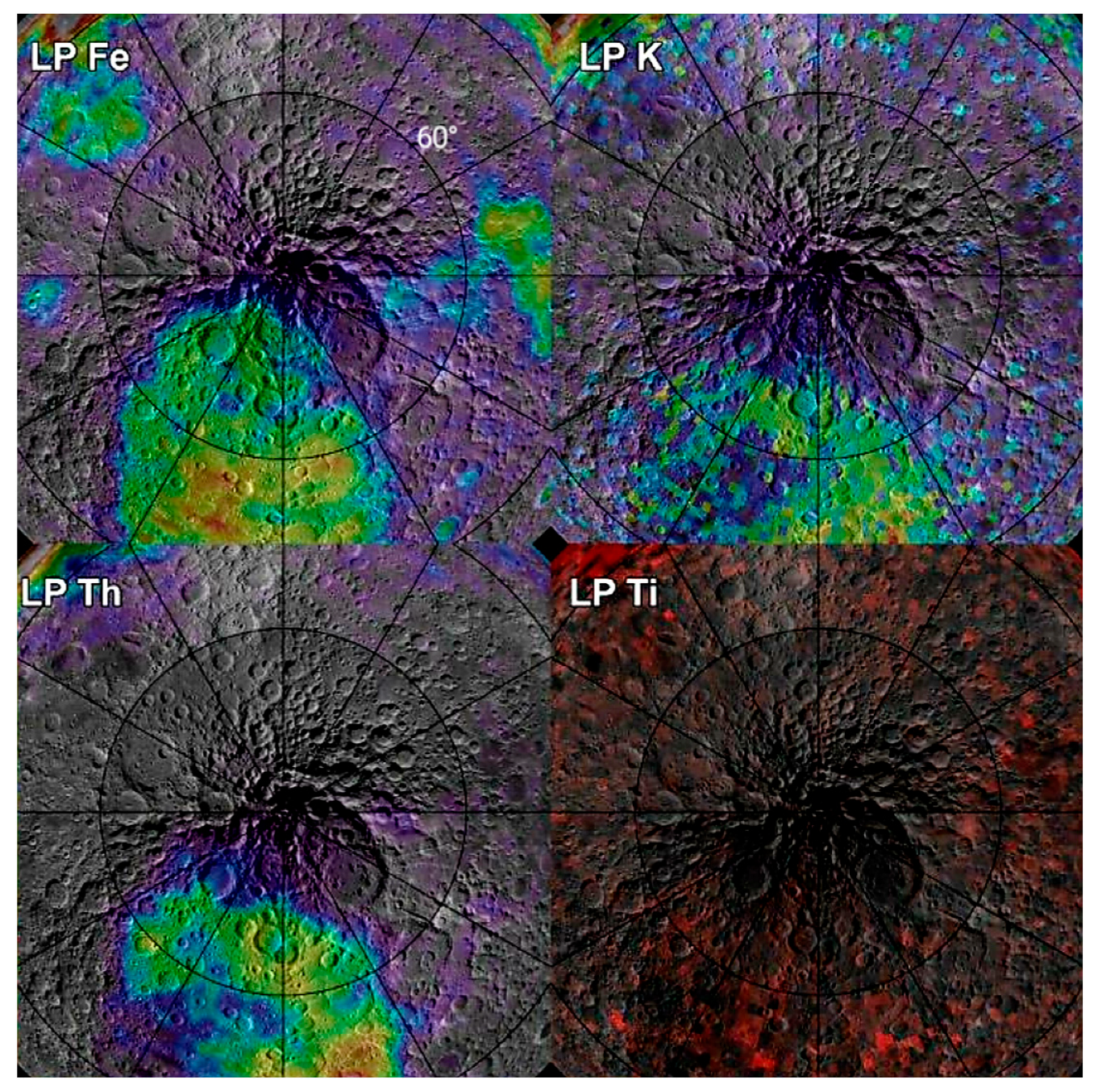

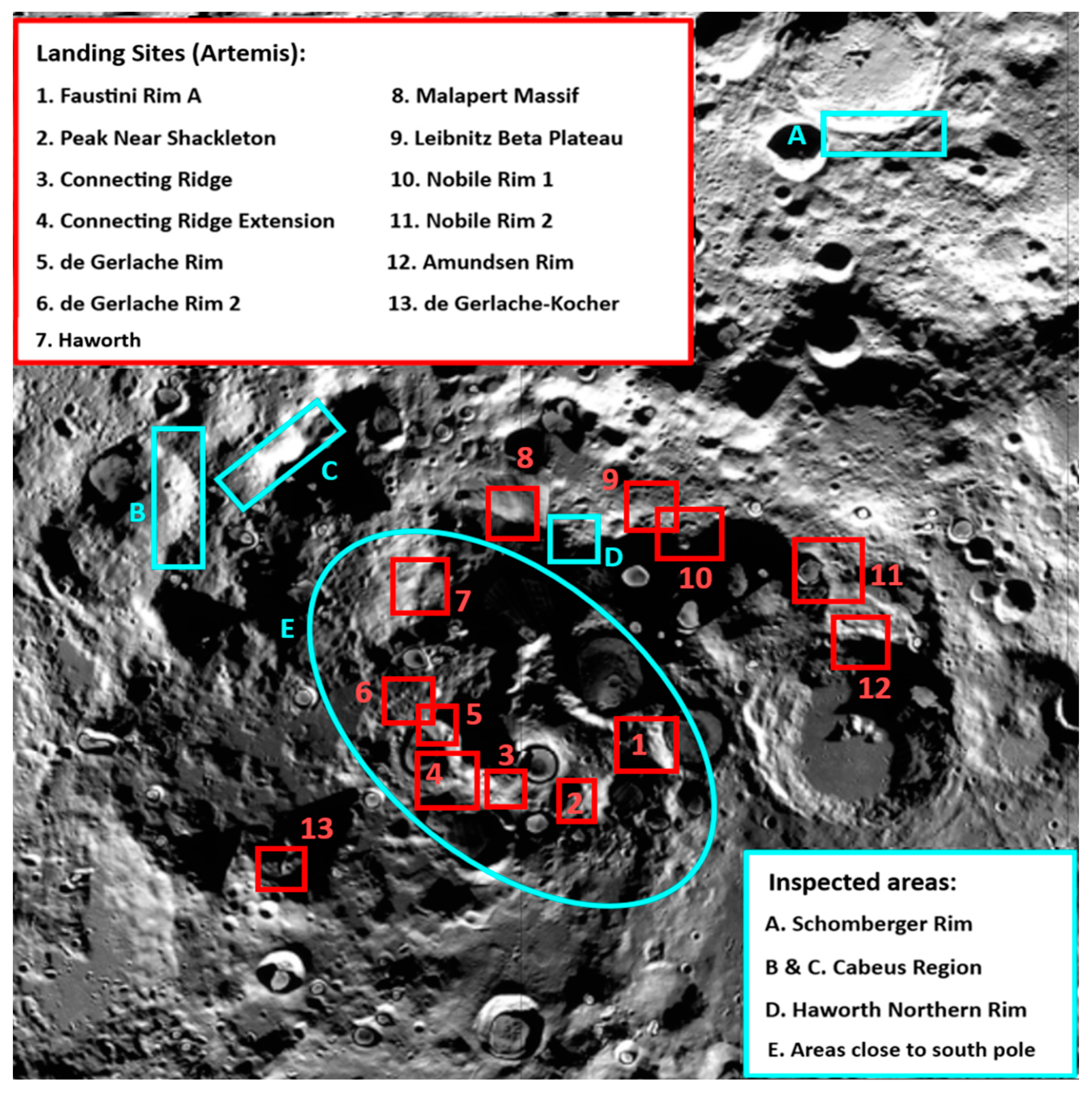
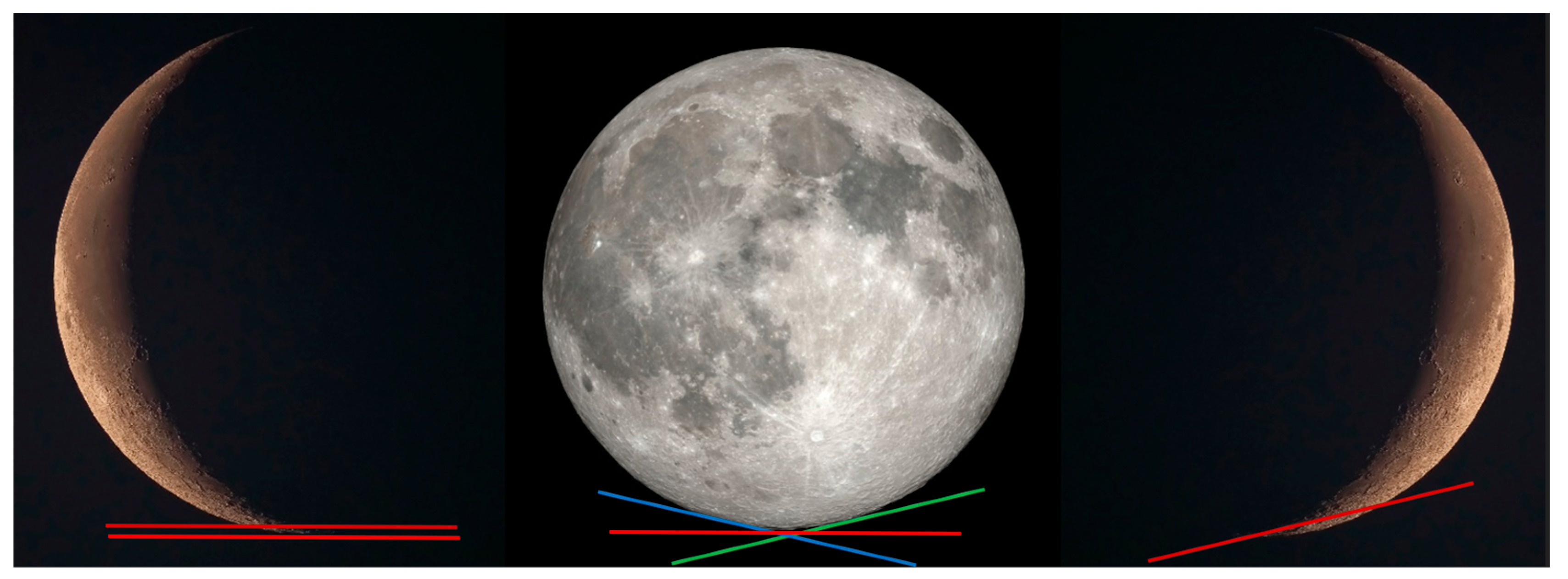


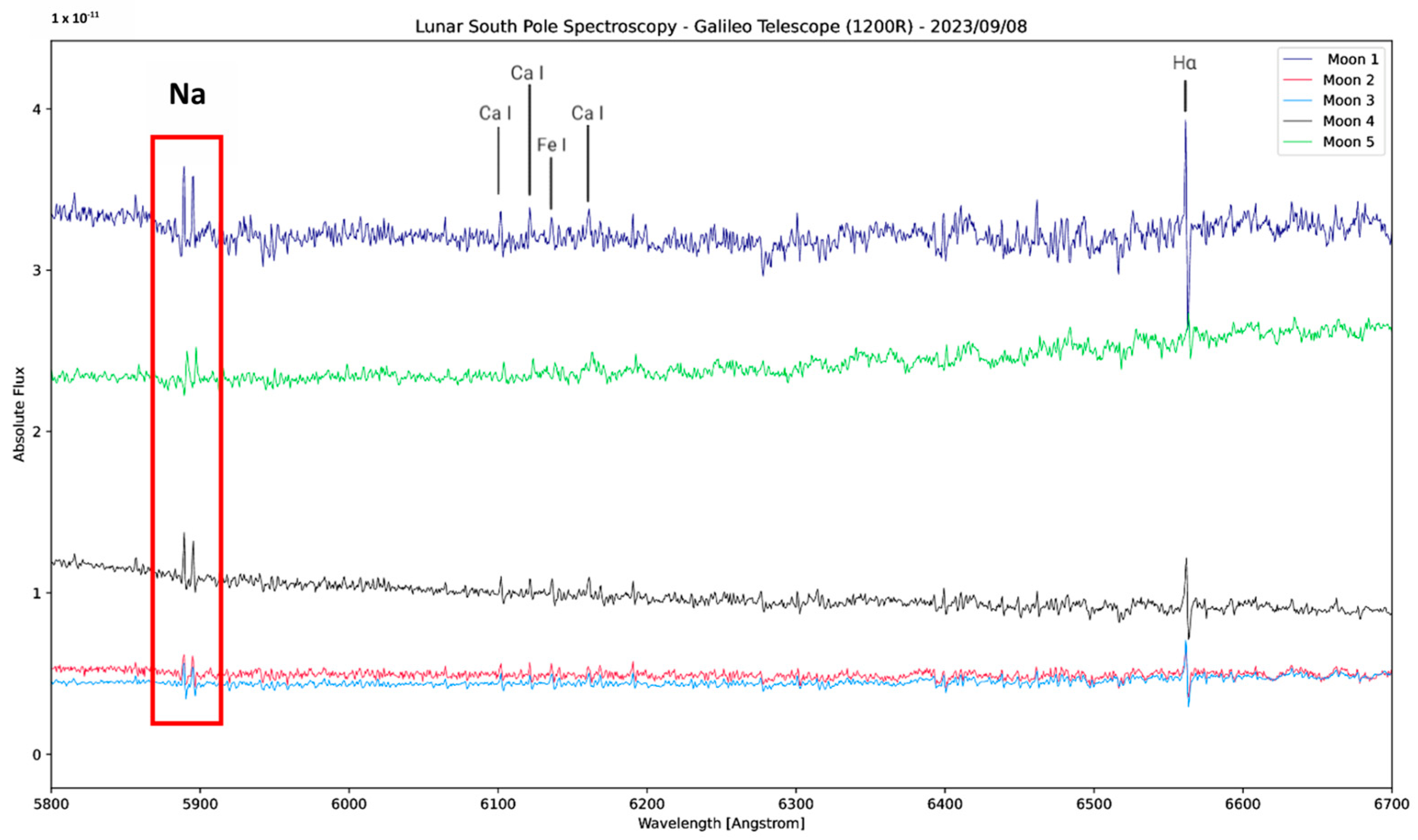
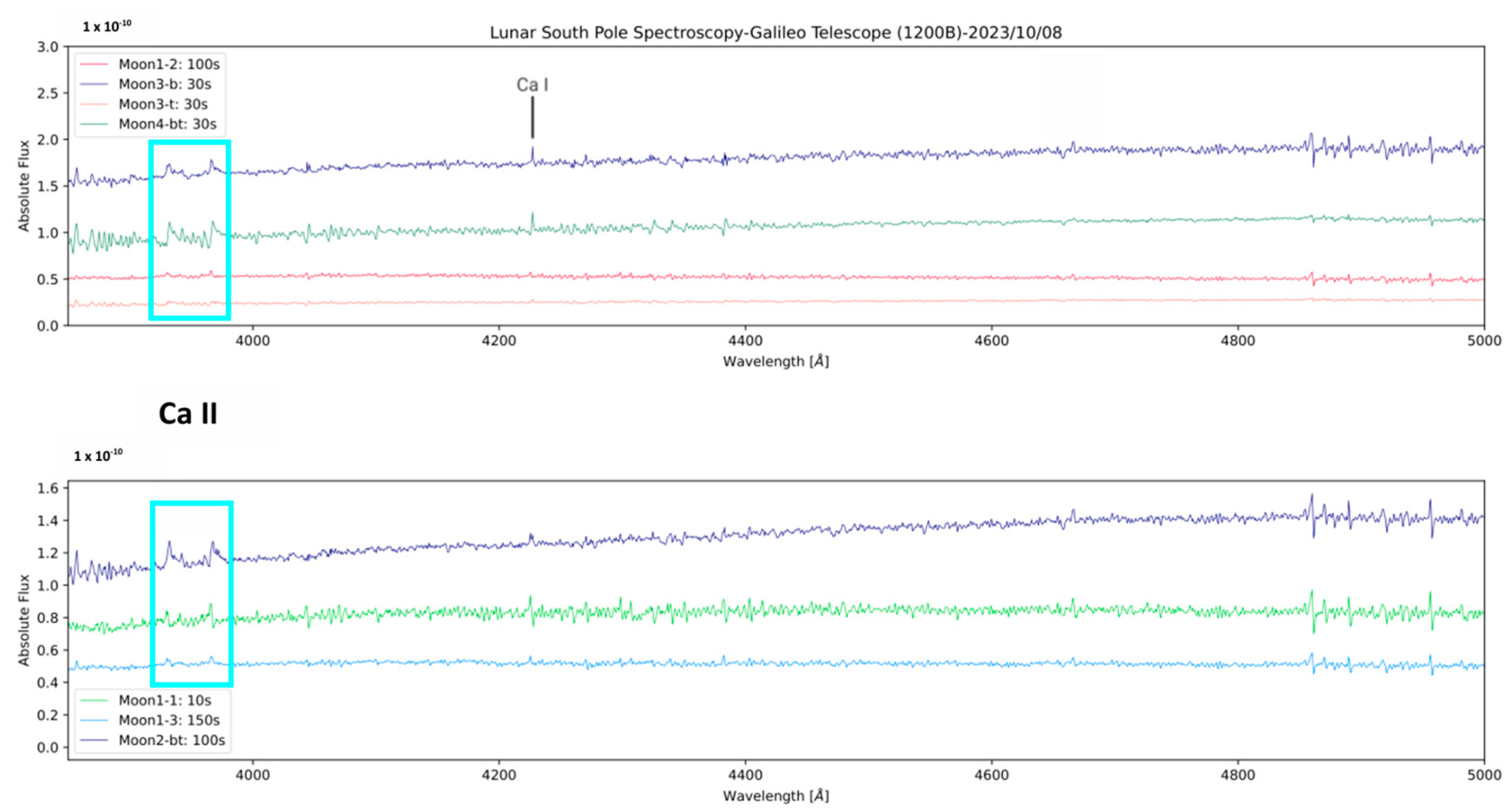

| Denomination | Lines/mm | Blaze Wavelength [Å] | Spectral Range [Å] |
|---|---|---|---|
| 300 | 300 | 5000 | 3500–7000 |
| 1200 R | 1200 | 6825 | 5750–7000 |
| 600 V | 600 | 4500 | 4250–6590 |
| 1200 B | 1200 | 4000 | 3820–5020 |
| Longitude | E 11°31′35.138″ |
| Latitude | N 45°51′59.340″ |
| Altitude | 1044.2 m above sea level |
| International code IAU-MPC | 043 |
| Primary mirror diameter (outer edge) | 1237 mm |
| Primary mirror effective diameter | 1200 mm |
| Primary mirror thickness (at the edge) | 208 mm |
| Primary mirror focal length | 6000 mm |
| Primary mirror focal ratio | f/5.0 |
| Secondary mirror diameter | 520 mm |
| Equivalent focal length | 12,100 mm |
| Focal ratio | f/10.1 |
| Scale | 17.05 arcsec/mm |
| Star | RA [hh mm ss] | Dec [° ′ ″] | V Mag |
|---|---|---|---|
| Land (SA) 93–101 | 01 53 18.0 | +00 22 25 | 9.7 |
| Hyades 64 | 04 26 40.1 | +16 44 49 | 8.1 |
| Land (SA) 98–978 | 06 51 34.0 | −00 11 33 | 10.5 |
| Land (SA) 102–1081 | 10 57 04.4 | −00 13 12 | 9.9 |
| Landolt (SA) 107–684 | 15 37 18.1 | −00 09 50 | 8.4 |
| Land (SA) 107–998 | 15 38 16.4 | +00 15 23 | 10.4 |
| 16 Cyg B | 19 41 52.0 | +50 31 03 | 6.2 |
| Land (SA) 112–1333 | 20 43 11.8 | +00 26 15 | 10.0 |
| Land (SA) 115–271 | 23 42 41.8 | +00 45 14 | 9.7 |
Disclaimer/Publisher’s Note: The statements, opinions and data contained in all publications are solely those of the individual author(s) and contributor(s) and not of MDPI and/or the editor(s). MDPI and/or the editor(s) disclaim responsibility for any injury to people or property resulting from any ideas, methods, instructions or products referred to in the content. |
© 2024 by the authors. Licensee MDPI, Basel, Switzerland. This article is an open access article distributed under the terms and conditions of the Creative Commons Attribution (CC BY) license (https://creativecommons.org/licenses/by/4.0/).
Share and Cite
Trabacchin, N.; Ochner, P.; Colombatti, G. A Physical and Spectroscopic Survey of the Lunar South Pole with the Galileo Telescope of the Asiago Astrophysical Observatory. Aerospace 2024, 11, 693. https://doi.org/10.3390/aerospace11090693
Trabacchin N, Ochner P, Colombatti G. A Physical and Spectroscopic Survey of the Lunar South Pole with the Galileo Telescope of the Asiago Astrophysical Observatory. Aerospace. 2024; 11(9):693. https://doi.org/10.3390/aerospace11090693
Chicago/Turabian StyleTrabacchin, Nicolò, Paolo Ochner, and Giacomo Colombatti. 2024. "A Physical and Spectroscopic Survey of the Lunar South Pole with the Galileo Telescope of the Asiago Astrophysical Observatory" Aerospace 11, no. 9: 693. https://doi.org/10.3390/aerospace11090693
APA StyleTrabacchin, N., Ochner, P., & Colombatti, G. (2024). A Physical and Spectroscopic Survey of the Lunar South Pole with the Galileo Telescope of the Asiago Astrophysical Observatory. Aerospace, 11(9), 693. https://doi.org/10.3390/aerospace11090693






